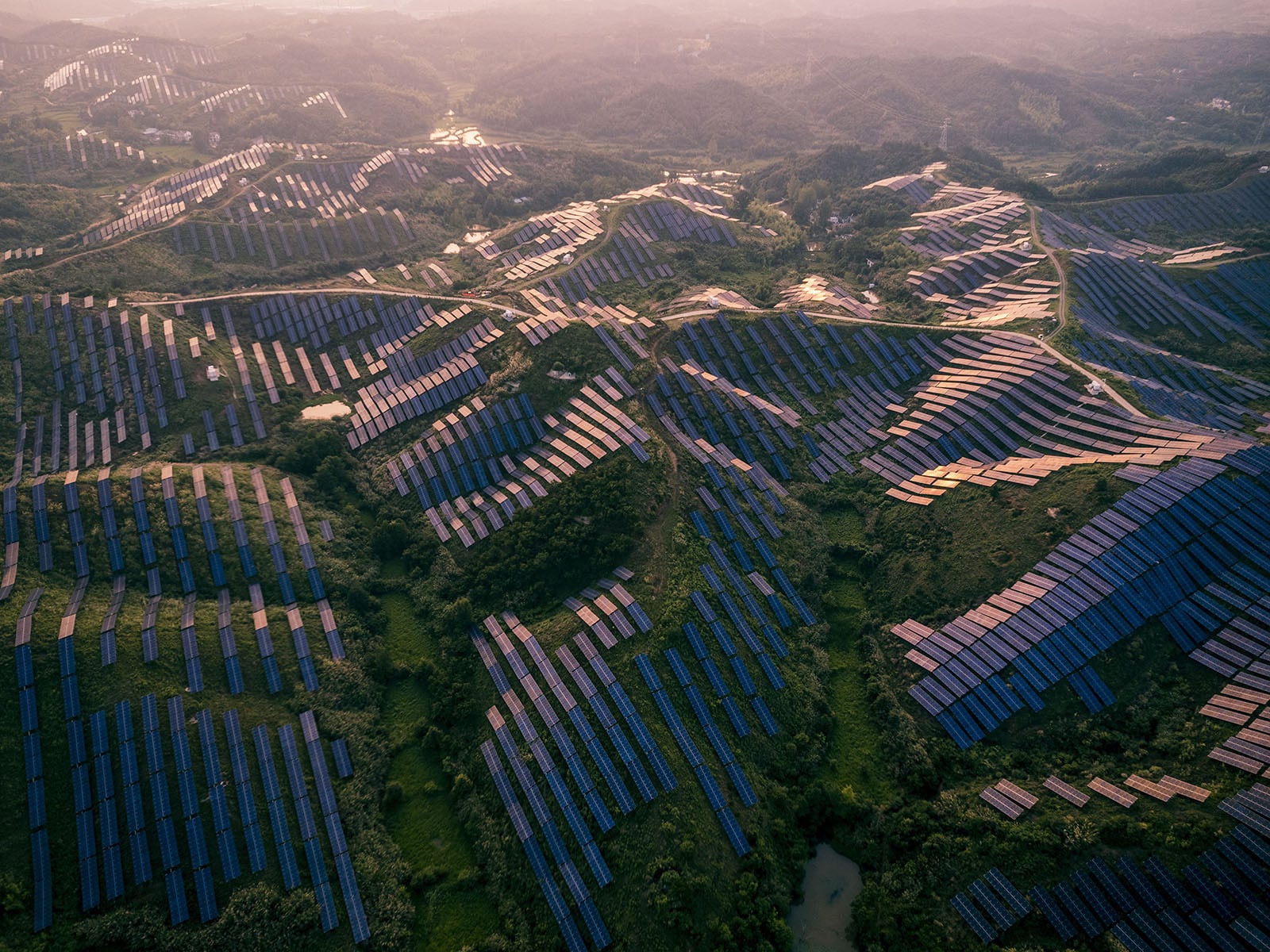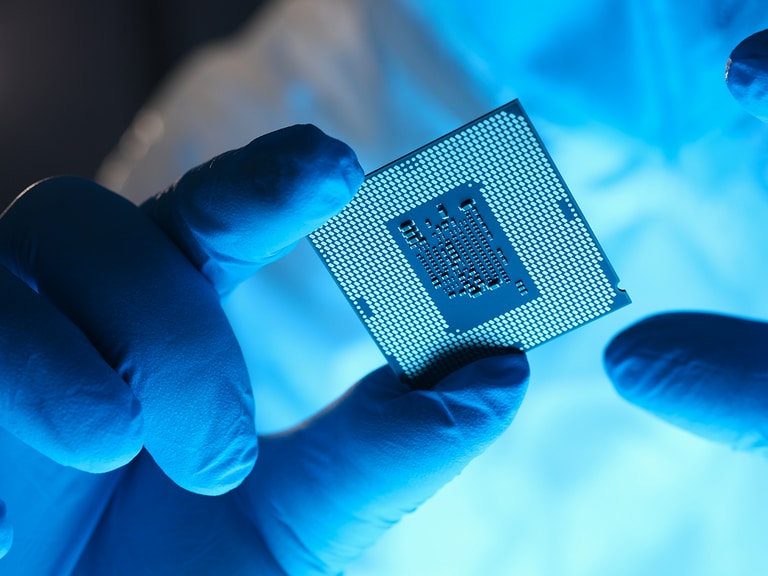1. Introduction
The solar energy market is one of the most heavily funded renewable power sources in the global energy transition. Frankfurt School – UNEP Collaborating Centre for Climate and Sustainable Energy Finance — noted that solar accounted for more than half ($1.4trn) of the $2.7trn global investment in renewable energy in the past decade, compared with $1.06trn in wind, $123bn in biomass and waste as well as $45bn in hydro. It’s estimated that the solar energy market could be worth $293.2bn by 2028, at a compound annual growth rate of 6.9%.
Solar technologies work by converting sunlight into electrical energy either through photovoltaic (PV) panels or concentrated solar-thermal power (CSP). A virtuous circle of environmental awareness, public desire for green energy, government subsidies and private investment has helped to increase the solar industry’s maturity.
Opto’s research suggests that the theme’s time horizon, the point at which we’ll reach peak solar energy usage, is 2038, which implies a medium-term window for investors to take full advantage of this high-potential theme.
“Solar accounted for more than half ($1.4trn) of the $2.7trn global investment in renewable energy in the past decade” - Frankfurt School – UNEP Collaborating Centre for Climate and Sustainable Energy Finance
2. Key players
JinkoSolar [JKS]
- Shanghai-based JinkoSolar is one of the world’s largest solar manufacturers.
- It produces more than 10% of the world’s solar panels.
- Its share of the PV cell market stands at around 12.8%.
- In 2020, it set a world record for efficiency with its PERC panels at 22.48%, then beat that mark in April 2022 when its TOPCon technology achieved 25.7% efficiency.
- In April 2022, it became the first to deliver 100 GW of solar modules.
- Outside China, Canadian Solar is one of the world’s largest solar tech firms. It owns business subsidiaries in 20 countries.
- The company has shipped around 70 GW of solar modules to customers in 160 countries.
- As of the end of 2021 it had 2,250 authorised patents around the world.
- In May 2021 it was the first company to deliver 600 W high-power solar modules using 210mm mono PERC cells.
First Solar [FSLR]
- The Arizona-based company was founded in 1990.
- In 2009 it became the first company to produce 1 W of power for under $1.
- By 2025 it plans to expand its facility in Ohio to a total annual capacity of 6 GW, which would make it the largest fully vertically integrated solar manufacturing complex outside China.
3. Background
The environmental benefits of solar power have been a key driver of the market’s performance over the past decade. With so many nations dependent on imported energy, and fossil fuels becoming unsustainable, investment in renewables is double that of coal and gas combined, according to EY Global. This, combined with the cost of solar tumbling 85% since 2010, has made solar energy costs comparable with fossil fuel electricity.
Historically, solar generation had always been costlier than wind, but a decision by the Chinese government in 2010 to make renewable energy a strategic industry ramped up production and led to a glut of affordable PV panels. As a result of this catalyst, IRENA says the cost of utility-scale solar PV electricity fell 82% in the 10 years to 2020, making it cheaper than wind for the first time. IRENA data also shows that production costs reduced so sharply that between 2010 and 2020 investment in renewables increased by 20%, but the power generation capacity it funded more than doubled. In 2012, the International Renewable Energy Agency (IRENA) forecast global solar energy generation would reach 550 TW/h by 2030 — it passed this figure in 2018.
4. Growth drivers
It was only in the early 21st century that scientists flagged climate change as an urgent and accelerating problem. Since then, the race to harness cheap, renewable alternatives to fossil fuels like solar energy has accelerated.
Here’s a snapshot of the some of the biggest growth drivers for solar companies
Government grants and subsidies —
Many countries offer grants for homeowners to offset the cost of installing solar panels. For example, in Germany, householders can receive up to a 45% subsidy for installation, and there are localised grants of up to €8,000 for installation in the Valencia region of Spain. In the US, the Solar Tax Credit provides a nationwide 22% tax credit on installation and individual states offer varying additional tax breaks, including property tax on the increased value of a home with PV power and payment for sales to the grid.
Falling costs —
The average global cost for solar power has fallen significantly in recent years, making it easier for households and businesses to switch to renewable energy. In the decade to 2020 it tumbled from $0.38/kWh to just $0.06/kWh. According to the World Economic Forum, each time solar capacity has doubled in the past decade, the price of installation has fallen 34%.
The Race to Zero —
The UN Climate Change Committee’s Race to Zero campaign has brought together governments, businesses and academic institutions across 120 countries in what the UN calls the largest ever alliance to commit to net zero by 2050. Its members are currently collectively responsible for 25% of the world’s carbon emissions and 50% of its GDP.
5. Investment case
Many countries have set a deadline of 2050 to reach net zero emissions. The world’s three largest polluters — the US, China and the EU — have all set goals of carbon neutrality by that date and the UK, Canada, Japan and New Zealand are among a growing number of countries to enshrine this target in law. Achieving all of this will depend on a necessary commitment to solar investment and adoption.
- The IEA claims that for the world to meet its net zero targets, 60% the planet’s power generation needs must be met by renewable sources by 2030.
- The push to tackle climate change is expected to accelerate demand for solar energy. For example, non-profit organisation Solar Energy UK predicts the country will have to treble its solar capacity to meet its 2050 net zero target.
- The cost of solar technology has plunged over the past decade from around $0.38/KWh in 2010 to around $0.06/KWh in 2022.
- Analysts at McKinsey forecast the demand for fossil fuels will peak and begin to decline in 2027. This will accelerate solar adoption into the following decade, with renewables consultancy Rethink Energy forecasting global solar additions will hit 1,022 GW in 2040.
- Solar will continue to have significant competition for investment. In 2021, coal, gas and oil continued to account for more than 60% of the world’s 28,214 TW/h of electricity.
- Rethink Energy forecasts that 2040 will be the peak of the solar boom, as the market’s potential for maximum investment profit will inevitably taper off, with most solar installations in the decade to 2050 being replacements rather than new instalments. However, the take-up of solar over the past decade has accelerated much faster than industry expectations, so that saturation point might come much earlier than forecast.
$0.6KWh
Cost of solar technology in 2022
6. Fund spotlight
Numerous exchange-traded funds (ETFs) offer exposure to solar, many as part of a wider clean energy theme. Funds with the biggest solar-weighting include:
This mid-cap ETF is weighted towards North American solar tech, with around half of its holdings based in the US. However, it does have exposure to several small-cap European solar firms and emerging markets. Its holdings have an average market cap of around $8bn. It has consistently concentrated between 25% and 30% of its portfolio into just three holdings — Enphase Energy, SolarEdge Technologies and Sunrun.
Top 10 holdings:
- SolarEdge Technologies [SEDG]
- Shoals Technologies Group [SHLS]
- GCL-Poly Energy [3GY.SG]
Global X Solar ETF [RAYS]
This large-cap ETF was launched in September 2021 with an exposure split between Chinese and US solar giants, headed since its inception by LONGi and TCL Zhonguan Renewable Energy Technology, which have consistently made up around 20% of the portfolio. The US and Asia accounted for almost 93% of its holdings as of July 2022.
Top 10 holdings:
- LONGi Green Energy Technology [601012.SS]
- TCL Zhonghuan Renewable Energy Technology [002129.SZ]
- Sungrow Power Supply [300274.SZ]
- SolarEdge Technologies [SEDG]
- JA Solar Technology [002459.SZ]
- Trina Solar [688599.SZ]
HANEtf Solar Energy UCITS ETF [TAN]
This ETF, launched in June 2021, includes several major Chinese and US players as well as a range of international firms, with 10% of its holdings in German companies. Although all of its holdings are pure solar companies, it has a broad industry exposure — none of its 41-strong portfolio has a weighting above 4.5%.
Top 10 holdings:
- West Holdings [1407.T]
- Solaria Energia Y Medio Ambiente [SLR.MC]
- SMA Solar Technology [S92.DE]
- Meyer Burger Technology [MBTN.SW]
- TSEC [6643.TW]
- SolarEdge Technologies [SEDG]
Other clean energy ETFs combine significant solar exposure with holdings in other renewable power sectors such as wind or hydroelectric. These include:
- First Trust Nasdaq Clean Edge Green Energy Index Fund [QCLN]
- SPDR Kensho Clean Power ETF [CNRG]
- VanEck Vectors Low Carbon Energy ETF [SMOG]
- iShares Global Clean Energy ETF [ICLN]
- Invesco Global Clean Energy ETF [PBD]
- SPDR MSCI ACWI Climate Paris Aligned ETF [NZAC]
7. Innovation and development
Solar technologies are evolving at an ever increasing rate, and its accelerated adoption is making this evolution ever faster. Recent years have seen new technologies replace each other at an exponential rate:
- After 30 years of relatively incremental technology developments, in 2018 the market was disrupted by a completely new solar cell structure. The passivated emitter and rear cell (PERC) technology improved efficiency and slashed costs overnight
- However, this is already being superseded by a system called tunnel oxidide passivated contact (TOPCon), which adds an ultra-thin oxide layer to PERC, enabling it to contain unabsorbed light.
- Both systems could quickly be overtaken by heterojunction (HJT), which enables a much simpler and quicker production process by using the cells’ necessary silver paste at a lower temperature. The storage and transportation of low temperature paste makes this currently more expensive than PERC or TOPCon, but when those costs come down it could quickly emerge as the leading technology in the market.
What role does artificial intelligence have to play in solar?
Industry trends are increasing the power of solar hardware and software. Artificial intelligence (AI) is helping the sector to develop in a number of ways:
- Smart solar panels are able to forecast the weather and automatically adjust the angle of panels, thereby maximising the collection of solar energy.
- AI can also forecast variable usage in the grid, predicting the times when power is most needed.
- Deep learning will use algorithms to predict when panels are vulnerable to fail, ensuring uninterrupted collection and storage of solar power.
- AI systems could enable entire cities to be powered by solar energy. AI models could simultaneously manage and coordinate infinite numbers of cells and batteries over a wide area, enabling the world’s first ‘solar cities’.
A key feature in the growth of solar adoption is the evolution of batteries towards the holy grail of cheap high-volume energy storage. Leaders in this field include Tesla [TSLA], Panasonic [6752.T], Albemarle [ALB] and Enphase Energy [ENPH].
Continue reading for FREE
- Includes free newsletter updates, unsubscribe anytime. Privacy policy





